 Taking Care of New Born – The first glimpse of the baby is very exciting time for every parent. If it is your first baby you may not be quiet prepared for what a newborn actually look like.
Taking Care of New Born – The first glimpse of the baby is very exciting time for every parent. If it is your first baby you may not be quiet prepared for what a newborn actually look like.
Many mothers like to bring up the child not according to what they are but what they expected him to be. Thus, parents sometimes make tomboys of their daughters or dress up their boys in girls’ clothes even when they are two or three years of age. This attitude may give them some satisfaction but it certainly harms the child.
“Is he alright?” is invariably the first question a mother asks. And the second question of every mother is “What is his weight?” All babies lose weight immediately after the birth. But they return to their birth weight within the first ten days. The baby should weigh approximately 3kg. (6 ½ lbs.). If he weighs less than 2.3 kgs. (5lbs) he may need special care. Such babies must be examined by the doctor.
Skin
 The skin of a newborn is usually covered with a cheesy material, which disappears, by itself. There may be some irregular areas on the head and on other parts of the body, which are called birthmarks. Most of these tend to disappear as the baby grows. Many babies have large bluish patches on the back, often around the hips. These are also birthmarks. Most birthmarks of this kind disappear in time, although a few may remain permanently. If however, you are concerned about some marks on the child’s face, consult your doctor.In some babies, the color of the skin turns slightly yellow about 48 hours after birth, because the liver has not fully matured. This is a normal phenomenon, which gradually disappears within three or four days after its first appearance. However, if the baby’s skin turn yellow within the first 48 hours or the color seems to increase in intensity, it is essential to consult a doctor immediately.
The skin of a newborn is usually covered with a cheesy material, which disappears, by itself. There may be some irregular areas on the head and on other parts of the body, which are called birthmarks. Most of these tend to disappear as the baby grows. Many babies have large bluish patches on the back, often around the hips. These are also birthmarks. Most birthmarks of this kind disappear in time, although a few may remain permanently. If however, you are concerned about some marks on the child’s face, consult your doctor.In some babies, the color of the skin turns slightly yellow about 48 hours after birth, because the liver has not fully matured. This is a normal phenomenon, which gradually disappears within three or four days after its first appearance. However, if the baby’s skin turn yellow within the first 48 hours or the color seems to increase in intensity, it is essential to consult a doctor immediately.
Head
 The head of the newborn is usually of an odd shape in the beginning, prominent in some places and flat in the others. You should not worry about this as the head takes its normal shape within two or three days after birth. It is desirable to change the sleeping position of the baby frequently. In some parts of India, the baby is put in a hammock. This type of cot provides uniform pressure to all sides of the head. The newborn’s face may also be asymmetrical; this is due to the posture of the foetus in the womb.The soft spots or fontanelles on top and at the back of the baby’s head are places where the bone has not yet developed. These spots are covered by a strong protective membrane across which the bone grows gradually. The one at the back closes by the end of second month while the one on the top of the head takes longer, up to about 12 to 18 months. Most mothers hesitate to clean the soft spots. As these are covered with strong membrane they can be washed with soap and even brushed with soft brush. If the spots are not kept clean, an accumulation of dirt may result in scaly crust and mild inflammation.A baby’s head and back need to be supported when he is picked up, as the muscles of the neck and back are not fully developed at birth. The child will be able to hold up his head by about the fourth month.
The head of the newborn is usually of an odd shape in the beginning, prominent in some places and flat in the others. You should not worry about this as the head takes its normal shape within two or three days after birth. It is desirable to change the sleeping position of the baby frequently. In some parts of India, the baby is put in a hammock. This type of cot provides uniform pressure to all sides of the head. The newborn’s face may also be asymmetrical; this is due to the posture of the foetus in the womb.The soft spots or fontanelles on top and at the back of the baby’s head are places where the bone has not yet developed. These spots are covered by a strong protective membrane across which the bone grows gradually. The one at the back closes by the end of second month while the one on the top of the head takes longer, up to about 12 to 18 months. Most mothers hesitate to clean the soft spots. As these are covered with strong membrane they can be washed with soap and even brushed with soft brush. If the spots are not kept clean, an accumulation of dirt may result in scaly crust and mild inflammation.A baby’s head and back need to be supported when he is picked up, as the muscles of the neck and back are not fully developed at birth. The child will be able to hold up his head by about the fourth month.
Legs
The newborn’s feet and legs may, at first, look abnormal; the legs may be bowed. This is the result of the position of the foetus in the womb. These mild abnormalities will gradually disappear by themselves.
Eyes
The baby keeps his eyes shut most of the time. He may blink at a bright light but is unable to see the details of an object. He starts focusing and begins to follow the light at the age of six weeks.The usage of Kohl (Kajal or surma) in the baby’s eyes may cause infection and discharge in the eyes. Many surma’s and Kajals contain lead, which can be poisonous if used over prolonged period of time. Most of the constituents of surma or kajal are washed away during bathing or they pass down into the nose through a little opening between the eyes and nose called nasolacrimal duct. This duct is very small and therefore gets blocked easily. The blockage may cause infection and discharge from the eyes.Clean the eyes with a piece of cotton boiled in water and later cooled. Massage the area of duct gently. Be careful not to have long fingernails. If these measures do not help, consult your doctor.
Nails
The baby’s nails should not be touched. If however, he often scratches his face, file the nails with a nail file but do not use scissors whose sharp ends can injure and infect the tender fingertips.
Nose
Do not get upset if the newborn baby’s nose looks very flat. The reason for this is that the bone of the nasal bridge is not fully developed at birth. There is a good chance of it looking attractive as he grows.The nose of the newborn is so small that the mucus inside the nostrils tends to dry up and obstruct breathing. Since the baby is not used to breathing through his mouth, he quickly feels uncomfortable and you may notice some odd sounds coming through his nose. If the baby’s nostrils are blocked, warm some water and after cooling it put a drop in each nostril. This will soften the secretions, which can then be cleaned with cotton bud.
Mouth
Sometimes the baby is born with one or two visible teeth. This is neither a good nor a bad omen. Only one baby in a thousand is born with one or two teeth. Nothing should be done about these teeth unless, of course, they are loose. Slightly loose teeth are best left alone as they will tighten up in the gums in due course. If the tooth is very loose and likely to fall, or hinders feeding, consult your dentist.
You may find two or three yellow, shiny, pearl-sized bodies on the baby’s palate. These are normal and would ultimately disappear. You can clean the tongue daily with boiled, cooled water if you wish, or just leave it alone. There is no need to clean it with glycerin. If the tongue has a thick coating of white, cheesy material, consult the doctor as the child may be suffering from thrush.
Ears
The newborn’s ear should be cleaned from the outside. Do not insert a cotton bud inside the ear canal. The wax formed inside the ear is automatically pushed out of the canal. The baby gets startled over a sudden noise, or sometimes even without a noise, or in his sleep. Occasionally, his jaw may quiver. This is because of the immaturity of his nervous system. However, when it frequently or the movements of limbs are more pronounced and rhythmic, consult your doctor as these may be convulsions which need treatment. At times even doctor has a hard time differentiating between natural quivers and convulsions in a newborn child.
Cords
The cord of the baby dries up fairly quickly, turns black and falls off towards the end of the first week or perhaps little later. Clean the cord and the area around the navel with spirit or after- shave lotion two to three times a day till it falls off. Continue doing so even a few days after the cord has fallen off. You may find that when the cord falls off there is some secretion from the area of the cord. All it needs is to be kept clean and dry with spirit. Do not use water to wash the cord and the area around it as this may cause infection. Do not use oil, ghee or powder on the cord. It is perhaps better to sponge the child leaving aside the area around the cords for first week before the cord falls off. Avoid giving tub bath in first two weeks.
Sometimes the navel bulges outward (Umbilical hernia). This bulging is quite common and is caused by the weakness of the muscles underneath. It usually disappears in time. However, if the bulge at navel is larger, it is advisable to consult your doctor.
Breast
In the first few weeks the baby’s breast may become enlarged. On pressing, a small quantity of whitish fluid may come out. This is caused by harmones in the mother, which prepare the breasts for lactation. Since the child himself cannot produce these harmones, the swelling disappears after a few weeks do not massage or foment the breast as this may injure the delicate tissue and cause infection.
Vagina and Penis
If the baby is girl, there may be whitish secretion from the vagina for the first week or two. Occasionally, there may be a little vaginal bleeding. These are due to the harmones of her mother. If the baby is a boy, his scrotum may be swollen and puffy. If it continues to look even after few days, consult your doctor. It may be due to a hernia, or, more likely, a type of water sac, which will disappear without treatment.
Hernias in this region – unlike the umbilical hernia – usually need prompt care. If the testis is not palpable in the bag, do not be alarmed. They may be lying above in the body. By cold touch they tend to retract upwards. Tell your doctor about them in your next visit. The foreskin of the penis in a newborn cannot always be pulled back. This does not necessarily mean that child needs operation (called circumcision) to make the opening clear. The foreskin will most likely retract by the time the child is five years old.
Urine and Stool
The baby usually urinates and passes a stool within 24 hours of life. His first stool may be dark green and rather sticky. However, after three or four days, it will become normal (yellow in color). The stool of a breast fed baby is usually loose and soft, whereas the stool of a bottle-fed baby is thicker and firmer. It is common a baby to pass stool soon after he has been fed. It is not uncommon for a breast fed baby to pass stool 6 to 10 times a day, it may be even more. If the stool change consistency and become watery and if there is any mucus or blood in them, you must immediately consult the doctor. An occasional baby may pass stool only once in two or four days; but as long as they are of usual consistency, they should be treated as normal and not constipated. It is only when his stools are hard and lumpy and he seems to feel pain while passing them that you should give him extra water with sugar. In most cases, this would soften the stools and relieve constipation.
Fresh Air
The child can be taken out in the fresh air and sunshine for an hour or two after the first two weeks. Cover him well if it is cold outside and don’t over-clothe him if it is warm. Avoid taking him out when it is dusty or windy. Don’t expose the baby to directly to the hot sun, as the child is likely to get sunburns quickly. In this respect, early morning sunshine is milder. Do not take him out in crowded areas or let neighborhood children touch and play with him at this age. Young children are likely to transmit their infections to him.
When the baby is two weeks old he should be taken to the doctor for his check-up. Subsequently check-ups can coincide with the baby’s immunization shots. Regular check-ups are essential for the baby. This will not only enable the doctor to know about the growth and development of the baby, but also to detect physical defects, if any, at the early stage.
Bathing The Baby
Bathing the baby can be a great fun. It not only cleans him bot also gives you the pleasure of handling him. In hospitals, the baby may not have been bathed, as some doctors do not recommend this for first few days. The baby’s head and face should have been washed and the genitals kept clean. At home he should have a sponge bath until the card is off and navel healed. The baby can be given sponge bath in the morning or evening but ensure that there is no draught in the room, that it is warm and that the temperature is about 80ºF (27ºC). Use a heater during winter as the infant may get cold and sick if the room is too cold. The water should be warm. The temperature of the water when tested with elbow should give a comfortable feeling.
Everything thing should be kept ready before you start undressing the child. Then, wrap him in a towel. Clean his face, head, neck, limbs, abdomen, and last of all his genitalia with wet towel. Do not use soap on his face. While cleaning the head, produce lather from the cake of soap on your hand and rub the head gently but firmly and rinse the soap thoroughly. If the head is not properly cleaned at regular intervals, dirt can accumulate, causing irritation and infection. When cleaning the genitalia and folds be sure that you dry them thoroughly, as any water left in the creases or in the folds of the groin and behind the ears may cause fungal or other infections.
In India, mothers are very particular in giving oil massage to their baby before bath. It is a mistaken belief that the oil makes the child stronger. Oil only keeps the skin healthy. Do not use mustard oil for massage, you can use any other oil which does not irritate the baby’s delicate skin. The massage should be done gently and playfully. Overzealous massaging, especially in summer, may cause infection of the skin. Indeed it is better if you skip it for the first few months.
When baby’s cord is dry and clean, you can give him a tub bath. Make sure not to leave the baby alone in the bath even when he is a year old; it can result in serious accidents like drowning and burns.
Use of talcum for children is not necessary. Do not sprinkle the powder directly, put it on your hand first and then gently rub it on the baby’s body. Do not leave too much powder in the folds of the skin, where it will mix with sweat and form thick plaques of powder; like massage, it is better to skip.
 Kids Portal For Parents India Kids Network
Kids Portal For Parents India Kids Network






